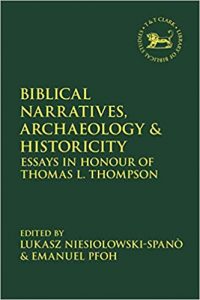Thomas L. Thompson está comemorando hoje 81 anos de vida.
NIESIOLOWSKI-SPANÒ, L. ; PFOH, E. (eds.) Biblical Narratives, Archaeology and Historicity: Essays In Honour of Thomas L. Thompson. London: Bloomsbury T&T Clark, 2019, 328 p. – ISBN 9780567686565.
This volume collects essays from an international body of leading scholars in Old Testament studies, focused upon the key concepts of the question of historicity of biblical stories, the archaeology of Israel/Palestine during the Bronze and Iron Ages, and the nature of biblical narratives and related literature.
stories, the archaeology of Israel/Palestine during the Bronze and Iron Ages, and the nature of biblical narratives and related literature.
As a celebration of the extensive body of Thomas L. Thompson’s work, these essays enable a threefold perspective on biblical narratives. Beginning with ‘method’, the contributors discuss archaeology, cultural memory, epistemology, and sociology of knowledge, before moving to ‘history, historiography and archaeology’ and close analysis of the Qumran Writings, Josephus and biblical rewritings. Finally the argument turn to the narratives themselves, exploring topics including the possibility of invented myth, the genre of Judges and the depiction of Moses in the Qu’ran. Presenting an interdisciplinary analysis of the historical issues concerning ancient Israel/Palestine, this volume creates an updated body of reference to fifty years’ worth of scholarship.
Lukasz Niesiolowski-Spanò is Associate Professor in the Institute of History at the University of Warsaw, Poland.
Emanuel Pfoh is Assistant Professor at the National University of La Plata, Argentina.
Table of contents
List of Figures
List of Contributors
List of Abbreviations
Introduction, Lukasz Niesiolowski-Spanò and Emanuel Pfoh
The Publications of Thomas L. Thompson
PART 1: METHOD
Chapter 1. The City of David as a Palimpsest – Margreet L. Steiner, Independent Scholar, the Netherlands
Chapter 2. Living in the Past? Keeping Up-To-Date in Ancient Near Eastern Studies – Raz Kletter, University of Helsinki, Finland
Chapter 3. What People Want to Believe: Or Fighting Against ‘Cultural Memory’ – Niels Peter Lemche, University of Copenhagen, Denmark
Chapter 4. The Need for a Comprehensive Sociology of Knowledge of Biblical and Archaeological Studies of the Southern Levant – Emanuel Pfoh, National University of La Plata, Argentina
PART 2: HISTORY, HISTORIOGRAPHY AND ARCHAEOLOGY
Chapter 5. The Abraham and Esau-Jacob Stories in the Context of the Maccabean Period – Lukasz Niesiolowski-Spanò, University of Warsaw, Poland
Chapter 6. Tell Balata (Shechem): An Archaeological and Historical Reassessment – Hamdan Taha, former Deputy of the Ministry of Tourism and Antiquities, Palestine, and Gerrit van der Kooij, University of Leiden, the Netherlands
Chapter 7. ‘Solomon’ (Shalmaneser III) and the Emergence of Judah as an Independent Kingdom – Russell Gmirkin, Independent Scholar, USA
Chapter 8. On the Pre-Exilic Gap between Israel and Judah – Étienne Nodet, École biblique et archéologique française de Jerusalem, Israel
Chapter 9. Perceptions of Israel’s Past in Qumran Writings: Between Myth and Historiography – Jesper Høgenhaven, University of Copenhagen, Denmark
Chapter 10. Is Josephus’s John the Baptist Passage a Chronologically Dislocated Story of the Death of Hyrcanus II? – Greg Doudna, Independant Scholar, USA
Chapter 11. Thompson’s Jesus: Staring Down the Wishing Well – Jim West, Ming Hua Theological College, Hong Kong
Chapter 12. The Qur’an as Biblical Rewriting – Mogens Müller, University of Copenhagen, Denmark
PART 3: BIBLICAL NARRATIVES
Chapter 13. The Food of Life and the Food of Death in Texts from the Old Testament and the Ancient Near East – Ingrid Hjelm, University of Copenhagen, Denmark
Chapter 14. A Gate in Gaza: An Essay on the Reception of Tall Tales – Jack M. Sasson, Vanderbilt University, USA
Chapter 15. Deborah’s Topical Song: Remarks on the Gattung of Judges 5 – Bob Becking, Utrecht University, the Netherlands
Chapter 16. How Jerusalem’s Temple Was Aligned to Moses’ Tabernacle: About the Historical Power of an Invented Myth – Rainer Albertz, University of Münster, Germany
Chapter 17. Can the Book of Nehemiah Be Used as an Historical Source, and If So, of What? – Lisbeth S. Fried, University of Michigan, USA
Chapter 18. Chronicles’ Reshaping of Memories of Ancestors Populating Genesis – Ehud Ben Zvi, University of Alberta, Canada
Chapter 19. The Book of Proverbs and Hesiod’s Works and Days – Philippe Wajdenbaum, Independent Scholar, the Netherlands
Chapter 20. The Villain ‘Samaritan’: The Samiri as the Other Moses in Qur’anic Exegesis – Joshua Sabih, University of Copenhagen
Index of References
Index of Authors